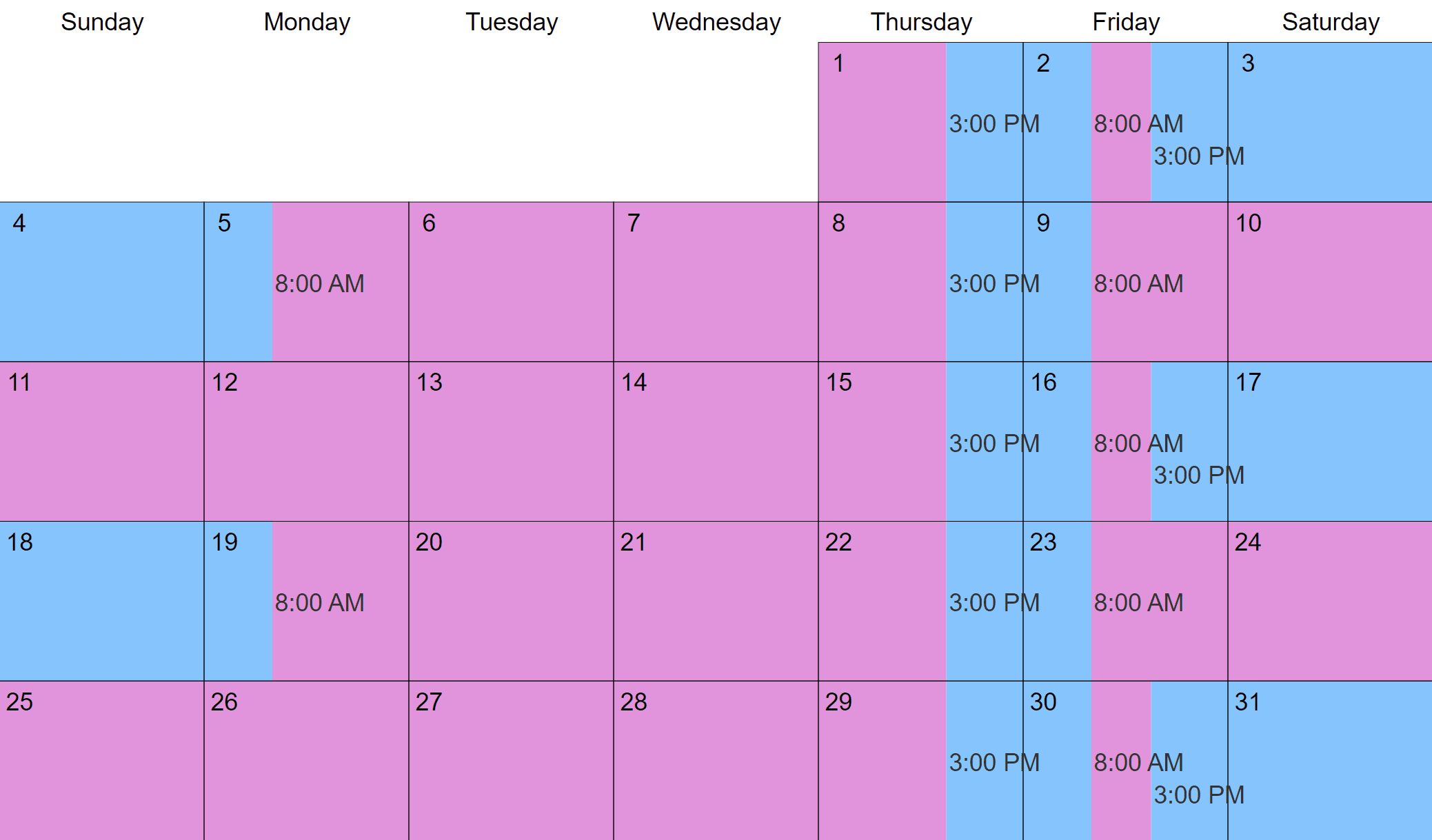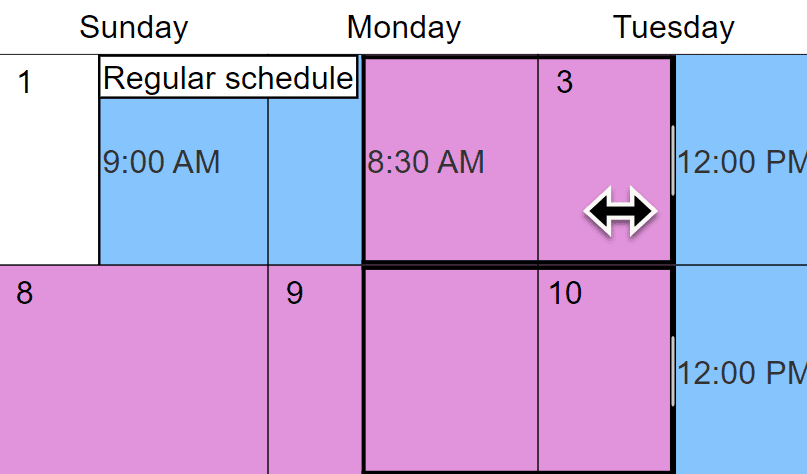
As part of the parenting plan that you and your co-parent draft separately or together, you should make a schedule describing when your child will spend time with each of you.
While the court may ask only for a brief written description, you can add a visual calendar for more clarity.
Anticipate breaks in your child's routine, like holidays. If it's important for your child, you'll be glad you wrote it down.
An Alabama judge will review your proposed schedule. If they approve it, it will become part of your court order in your divorce or custody case.
Visualize your schedule. Get a written parenting plan. Calculate your parenting time.
When you open a divorce or custody case, whether or not you have a settlement ready, you'll ask for an order about your child's physical custody. You can ask for a temporary schedule (to follow during the case) in addition to your final one.
Agree on as much as you can. If you agree on everything, the judge is likely to approve your joint proposal and make it a court order. If you can't agree on some things despite your best efforts, you'll have to go to trial to decide those.
The judge may give one parent sole physical custody and the other visitation rights — or give parents joint physical custody, especially if this is what both parents want. When the judge doesn't say any more, you're responsible for working out your visits with each other.
The judge may add minor details about visits or exchanges. Or they can decide on a thorough schedule, particularly if either parent requested one. It's hard for them to write one from scratch since they don't know everything about your family. The judge hopes you'll provide a detailed draft as part of your broader parenting plan.
You can quickly visualize and compare schedules with a Custody X Change calendar. Choose from templates for common schedules or build your own schedule.
Of course, your child's needs will change. As they get older, they may be comfortable spending more time away from a parent. Consider specifying dates when your parenting schedule will automatically change or when you and your co-parent will discuss making a change. You might consider ranges of 0–3, 4–5, 6–12 and 13–19 years, as suggested by the Alabama Law Institute.
In some situations, parenting time is seen as a risk to the child. In those situations, the court can recommend safe scheduling options. For example, a step-up plan provides structure for an uninvolved parent re-entering the child's life. You may hear it called a reunification schedule.
Alabama courts and judges often have standard schedules, which they order parents to follow when the parents don't agree to a schedule and no other schedule makes more sense.
You may find this in your county. If you like your court's or judge's standard schedule, you can make it part of your settlement agreement or your individual proposal. But you don't have to.
In Madison County's standard schedule, the noncustodial parent has the child for the first, third and fifth weekends in a month, plus an overnight visit every Thursday.

If you live in another county, check your court's website for a standard schedule or ask your judge or court clerk.
Standard schedules may also come with rules about things like how far in advance parents must cancel visits and how long they must wait for each other to show up.
Judges do realize that young children have unique needs and that parents exchange their child less frequently when they live far apart. For situations like these, a judge might adapt the standard schedule to suit the family or pick a more appropriate schedule.
What will your co-parenting schedule look like? Here are some common options.
The 2-2-3 schedule involves frequent exchanges (appropriate for small children).


In the 2-2-5-5 schedule, the child has two days with one parent, two days with the other, then five days with one, five days with the other.

An older child may spend one week with one parent, then the next week with the other. The exchange often happens at the end of the school week. This is called alternating weeks.

The 4-3 schedule repeats every week. This is close to a 60/40 time split.

Some children live every weekend with the parent they see less. This is a 70/30 time split.

If one parent has three daytime visits every week (appropriate for babies), the parents have roughly a 90/10 division of time.

Plan for the school year in a way that supports your child's school attendance, and don't forget holidays and summer breaks.
For short school breaks — fall, Thanksgiving, winter and spring — specify whether your child should spend the entire break with one parent. Some parents alternate who gets the child during the break each year. Another option is to split your parenting time during that break every year.
For summer break, you may need a more detailed schedule planning all your exchanges. Often the noncustodial parent gets the majority of this time.
Plan for other breaks in your child's routine, like retreats, tournaments and visiting extended family. If you don't have dates yet, you can decide on a general approach now or just wait until later to agree on how your schedule should adjust.
Be practical. How far apart you live affects how frequently you'll exchange your child and how you'll do it.
You each have a right to your court-ordered custody or visitation time. You can't withhold parenting time to bargain with or punish each other — not even for missing child support payments.
If your co-parent isn't following the schedule as ordered, log what happens and track your actual parenting time. You can do both with the Custody X Change online app. You can use the information to discuss the issue with them directly, or you can take the information back to court.
If you return to court, the judge may order a performance bond for the parent who's asked to prove their compliance. The parent pays a relatively small service fee to the bond company and puts up cash (or a letter from a bank saying the cash is available) for the bond amount. If they comply with the custody order, the bond company eventually returns (or never charges) the bond amount.
Another option in Alabama is to pursue contempt charges. If a parent is found guilty, they can be briefly jailed or fined.
If you're like most parents, creating a custody and visitation schedule will feel daunting. How do you make something that meets legal requirements and doesn't leave any loose ends?
The Custody X Change app makes it easy. Either customize a schedule template, or click and drag in your custody calendar to make a schedule from scratch.

Then watch a full description appear in your parenting plan.

The combination of a visual and written schedule means your family will have no problem knowing who has the child when. Take advantage of Custody X Change to make your schedule as clear and thorough as can be.
Visualize your schedule. Get a written parenting plan. Calculate your parenting time.